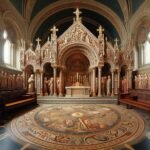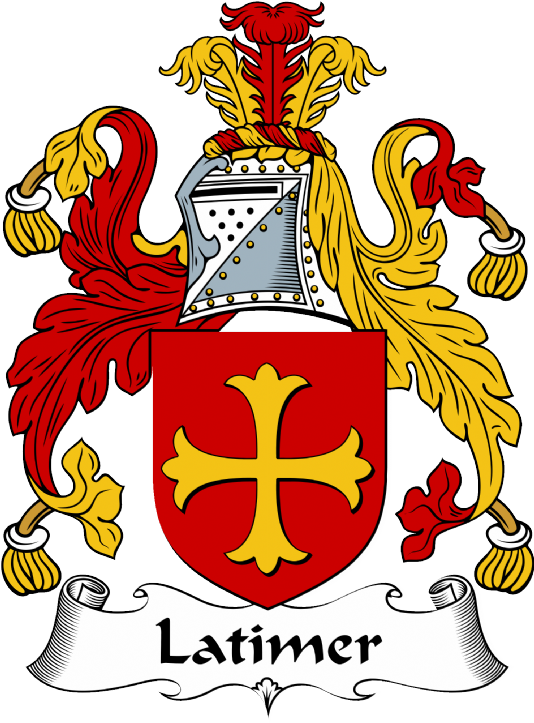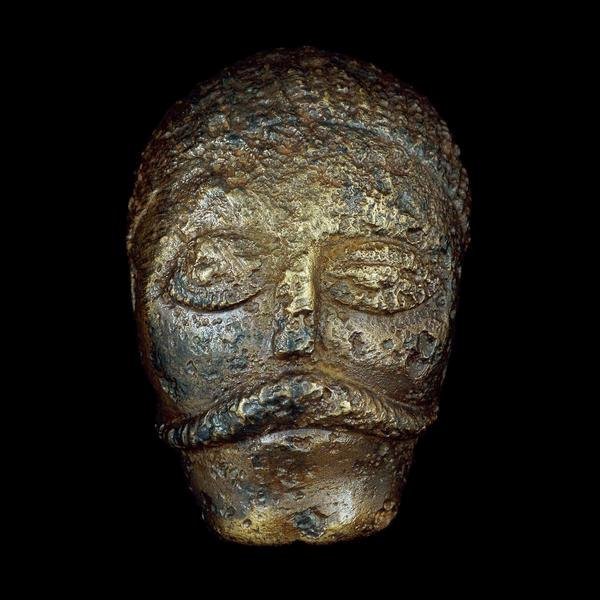Contents
Site Details:
 St Michael & All Angels Church, nestled in the serene setting of Hubberholme in North Yorkshire, is a historical gem dating back to the 12th century. The church is renowned for its peaceful atmosphere and has been a place of worship and reflection for centuries.
St Michael & All Angels Church, nestled in the serene setting of Hubberholme in North Yorkshire, is a historical gem dating back to the 12th century. The church is renowned for its peaceful atmosphere and has been a place of worship and reflection for centuries.

Window presenting the Percy family for reverence.
Moreover, the church's architectural features speak to the craftsmanship of Robert "Mouseman" Thompson, whose work is renowned in the region. His distinctive mouse carvings on the church's furniture are a testament to the artistry that flourished in Yorkshire during the 20th century. These carvings are not merely decorative; they symbolize the church's embrace of local talent and the integration of community identity into its sacred space.
 Jacobean Altar
Jacobean Altar
The church also houses a Jacobean altar, originally from the chapel at University College, Oxford, donated in 1862. This piece adds a layer of academic and religious history to the church, connecting it to one of the oldest universities in the English-speaking world and showcasing the church's role as a custodian of artifacts that span both time and geography. A Jacobean altar, characteristic of the period during the reign of James I of England from 1603 to 1625, would likely exhibit a blend of late Perpendicular Gothic and early Renaissance elements. The overall design would be substantial and robust, reflecting the architectural and artistic sensibilities of the time. You might find heavy use of oak wood, which was commonly used in Jacobean furniture, along with bulbous legs and carved decorations that could include motifs such as acanthus leaves, rosettes, and arabesques. The altar might also feature classical columns or pilasters, arches, and possibly strap work – a type of decoration resembling studded leather straps, cut into intricate, geometric patterns.
These features would be combined with a sense of symmetry and proportion influenced by the classical orders, but interpreted with a distinctly English flair that often included more ornate and elaborate detailing than the purer Renaissance styles found in Italy. In addition to these, the altar could be adorned with rich fabrics and possibly detailed metalwork, adding to its visual and tactile richness. The Jacobean era was a time of transition in English design, and a Jacobean altar would embody this bridge between the medieval and the renaissance, the gothic and the classical, creating a piece that was both of its time and timeless in its appeal.
Wooden Rood Loft
The wooden Rood Loft inside the church dates from1558 and is particularly significant, having survived the edict of Elizabeth I to destroy such structures.
The wooden Rood Loft, a historic architectural feature within many medieval churches, holds a special place in ecclesiastical history, particularly those that have withstood the test of time and the sweeping reforms of religious practices. The edict of Elizabeth I, which came during the English Reformation, marked a significant shift in religious and cultural practices, leading to the removal and destruction of many rood lofts. These lofts were often elaborate, ornately carved structures that housed the rood—a representation of the crucifixion scene with figures of Christ, Mary, and John—and were a focal point for worship within the church.
The survival of such a wooden Rood Loft is remarkable, as it stands as a testament to the craftsmanship and religious significance of the period before the Reformation. It also serves as a physical reminder of the turbulent times when the Church of England was breaking away from the Roman Catholic Church, and religious iconography was being reevaluated and often removed under the new Protestant doctrine. The fact that this particular Rood Loft escaped destruction suggests it may have been hidden or protected by parishioners who valued its religious and artistic importance, or perhaps its survival was simply an oversight during a time of widespread change.
Today, the presence of a surviving wooden Rood Loft can offer invaluable insights into the past, providing historians and visitors alike a direct link to the practices and aesthetics of pre-Reformation worship. It also underscores the complex relationship between politics, religion, and art throughout history, illustrating how shifts in power and belief can have lasting impacts on cultural heritage.

 Early Font
Early Font
The date of the font is currently unknown, however, given it includes two archaic heads, it is likely to be older than the current church, and these heads reflective of earlier beliefs being incorporated into the early Christian beliefs reflected by the church.
 This early sundial was restored by the Langstroth's of the USA, in memory of the Langstroth's of Langstrothdale. Indicating the family no longer reside at what they may consider to be a point of origin.
This early sundial was restored by the Langstroth's of the USA, in memory of the Langstroth's of Langstrothdale. Indicating the family no longer reside at what they may consider to be a point of origin.
The Langstroth family, known for their significant contributions to apiculture (beekeeping) in the United States, is believed to have roots that trace back to Langstrothdale, a scenic valley in the Yorkshire Dales in North Yorkshire, England. This area, rich in history and natural beauty, was first colonized by Anglians in the seventh century, with Norse invaders arriving later.
The name Langstrothdale itself derives from Old English and translates as 'long marsh' or 'marshy ground'. It's a place steeped in history, from its early colonization to its role in Norman times when many of the isolated settlements were allowed to remain but were prevented from expanding due to the 'Forest Law'. The dale was well forested at that time and was known as Langstrothdale Chase, a royal hunting forest. In the 1600s, the lands became part of the Clifford family's holdings, but due to financial strains, they were sold, allowing many Dalesfolk to purchase their own farmsteads.
The Langstroth family in the USA is most notably connected to Reverend Lorenzo Lorraine Langstroth, often called the 'Father of American Beekeeping'. He is credited with inventing the modern beehive structure, which revolutionized beekeeping by allowing honey to be harvested without destroying the hive. His lineage, while not extensively documented in relation to Langstrothdale, carries the legacy of a name deeply connected to the natural world and its stewardship. The Langstroths of the USA, through their advancements in beekeeping, have demonstrated a profound respect for nature and a spirit of innovation that may well echo the resilience and resourcefulness of their ancestors from Langstrothdale.
J. B. Priestley
J.B. Priestley, a distinguished English novelist, playwright, and broadcaster, held a deep affection for the St Michael & All Angels Church in Hubberholme. His connection to this serene sanctuary was not merely one of casual visitation but of profound personal significance. Priestley, born in the nearby city of Bradford, found in Hubberholme's church a place of solace and inspiration, describing it as "the smallest, pleasantest place in the world." His frequent visits to the church and the adjacent George Inn, a historic establishment, are well-documented and reflect his attachment to the area's natural beauty and tranquillity.
The churchyard of St Michael & All Angels is the final resting place for Priestley's ashes, a decision that underscores the depth of his connection to this place of worship. The church also honours his memory with a commemorative plaque, a subtle yet enduring acknowledgment of his legacy and his love for this corner of Yorkshire. Priestley's choice to be interred here speaks volumes about the church's importance to him, serving as an everlasting testament to his bond with the region and its people.
Priestley's relationship with the church was not just personal, but also contributed to its cultural significance. His prominence as a literary figure attracts visitors and admirers to Hubberholme, many of whom come to pay homage to the author at his final resting place.
Other notable figures associated with the church include George Andrew Hobson, a civil engineer of the late Victorian era, whose legacy is immortalized within the church's stained-glass windows. These windows celebrate his engineering marvel, the Victoria Falls Bridge, which spans the Zambezi River between Zimbabwe and Zambia, constructed in 1905. This tribute within the church highlights the community's respect for individuals who have made significant contributions to society, whether through literature, as with Priestley, or through the advancements of engineering, as with Hobson.
Site Gallery
Gallery Empty













